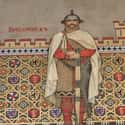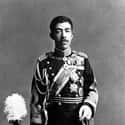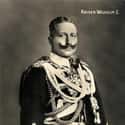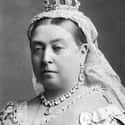-
(#1) Herod the Great
Though King Herod probably suffered from chronic kidney disease, his final years were plagued by a new affliction: Fournier’s gangrene, a form of gangrene typically relating to the most private physical areas of the afflicted. According to the ancient historian Flavius Josephus, Herod “had a terrible craving to scratch himself, his bowels were ulcerated, and his privates gangrenous and wormy.”
Herod’s discomfort was so extreme it may have heightened his feelings of depression and irritability (both side-effects of his kidney disease). This may account for his ruthless reputation, especially later in life.
-
(#2) Baldwin IV of Jerusalem
- Dec. at 24 (1161-1185)
Leprosy - an affliction that targets flesh and tissues - was one of the most misunderstood diseases of the medieval world - and it didn’t discriminate between prince or pauper.
King Baldwin IV of Jerusalem was a leper. Though it’s unclear when or how he contracted the disease, he showed symptoms of it by the age of 9. Even so, his affliction didn’t hinder his ability to rule Jerusalem in any way. Contemporaries indicated Baldwin’s subjects “took no notice whatsoever of his leprosy.” Baldwin’s status ultimately helped destigmatize the disease.
-
(#3) Piero di Cosimo de' Medici
- Dec. at 53 (1416-1469)
Known as the “disease of kings,” gout - or the painful swelling of joints - has indeed afflicted the rich and famous throughout history. It’s usually brought on by a rich diet, something peasants generally couldn’t afford. Piero il Gottoso (AKA Piero the Gouty) suffered from gout since childhood. It got so bad that it eventually paralyzed him. Accounts from the Medici court suggest the only body part he could move was his tongue.
-
(#4) Alfred the Great
- Dec. at 50 (849-899)
One of the last Anglo-Saxon kings, Alfred the Great suffered from painful ailments all his life. Crohn’s disease, or severe inflammation of the bowels, may have been among his afflictions. According to his biographer, Asser, Alfred prayed to be stricken with an illness to help curb his intimate appetites. To Alfred, having the ailment was evidence of his suffering and role as a supplicant to God.
-
(#5) Richard III of England
- Dec. at 33 (1452-1485)
After studying Richard III’s bones, scientists determined he had scoliosis - a curvature of the spine - that probably developed soon after he turned 10. By adulthood, the curve in Richard’s back was so obvious it prompted one chronicler in the late 15th century to describe the king as “small of stature, with a short face and unequal shoulders, the right higher and the left lower.”
Though the disease didn’t debilitate Richard - he was slain in combat - it did inspire critics to malign him by using his curved back as evidence of his supposedly crooked character.
-
(#6) Empress Elisabeth of Austria
- Dec. at 61 (1837-1898)
Elisabeth of Austria was a celebrated beauty with a famously slender waistline - but it came at a cost. To stay slim, she often refused food - or lived on a diet of broth - and exercised constantly.
Elisabeth’s lack of consistent nutrition and calories caught up with her: she developed edema (or painful swelling) in her feet. When she was still in her 20s in the 1860s, Elisabeth’s edema in her feet got so bad that she sometimes required assistance while walking.
-
(#7) Emperor Taishō
- Dec. at 47 (1879-1926)
Three weeks after his birth on August 31, 1879, Taishō fell ill with cerebral meningitis, a pathogen-induced swelling of the brain and spinal cord. However, he pulled through and became Emperor of Japan in 1912.
Taishō’s fight with meningitis may have had an effect on his neurological development. At least, that’s what the Japanese government claimed when it issued a proclamation in 1921 that named his son as regent. The document claimed Taishō’s “physical and mental development has been somewhat delayed” due to periods of ill health since childhood.
-
(#8) Henry VIII of England
- Dec. at 56 (1491-1547)
When Henry VIII became King of England at the age of 17 in 1509, he was a lion among men: he was intellectually and physically active and obsessed with upholding the ideals of a Renaissance prince.
But Henry’s glory days faded with age. When he was 36, he developed sores on his legs - probably from garters. Worse, a leg injury he sustained during a jousting tournament in 1536 became ulcerated. His leg ulcers festered and reeked over time: people could smell them several rooms away. The pain soured his mood, and Henry became increasingly tyrannical: he lopped off the heads of two of his wives and anyone who disagreed with his politics.
-
(#9) Pope Leo X
- Dec. at 46 (1475-1521)
A scion of Florence’s powerful Medici family, Pope Leo X was a significant political player on the early 16th-century Italian peninsula. But from the age of around 37, he suffered from fissures of the large intestine so severely that he insisted that a physician travel with him.
Leo’s treatment for these colonic fissures was also a political liability. In 1516, rival cardinals hatched a plot to take out Leo by tampering with the pope’s bandages. The scheme was discovered, and Leo continued to serve as pope until pneumonia took him in 1521.
-
(#10) Charles II of Spain
- Dec. at 39 (1661-1700)
Years of Habsburg inbreeding led to physical and mental ailments for King Charles II of Spain. When Charles was born in 1661 to Philip IV of Spain and Mariana of Austria (Philip’s niece), it was clear the boy inherited health troubles: he didn’t have the ability to speak until he was 4 and struggled to walk before he turned 8.
Scientists believe Charles II had a host of afflictions, ranging from a pituitary hormone deficiency - which made him short and sterile - to distal renal tubular acidosis - a kidney disease that leads to acidic blood. He also suffered from seizures and a protruding jaw that made it difficult to eat.
Charles’s inability to produce an heir ushered in a succession crisis, culminating in a conflict in 1701. Charles’s passing in 1700 ended the Spanish branch of the Habsburgs.
-
(#11) Wilhelm II
- Dec. at 82 (1859-1941)
In the process of helping the future Kaiser Wilhelm II survive his breech birth in 1859, the attending physician damaged nerves in the newborn’s arm. Wilhelm’s erb palsy - or nerve damage to the upper arm - resulted in a withered arm.
Wilhelm consequently had a difficult time using his arm and didn’t have the ability to perform basic functions, like slicing some foods. He was also subjected to severe treatments, such as electrotherapy. Though there is not a direct correlation between his rule of Germany and his condition, he went to great lengths to disguise his withered arm so as to appear a physically strong figure.
-
(#12) Tutankhamun
Analyses of King Tutankhamun’s bones determined the young pharaoh suffered from a litany of health issues. King Tut’s many ailments can be attributed to him being a child of inbreeding and inheriting DNA from a shallow gene pool. Among his afflictions was Kohler disease, a rare genetic disorder that probably caused severe foot pain and gave him an uneven gait. The disease may have been so painful he needed a cane or crutch to walk.
-
(#13) Peter the Great
- Dec. at 53 (1672-1725)
Peter the Great - the man who aggressively Westernized Russia - suffered from bladder and urinary tract issues during the final years of his life. Though it’s unclear how long Peter dealt with uremia - severe retention of urine - he apparently suffered from a blocked urethra in 1722. His painful episodes almost always resulted in periods of bed rest. His final bout of uremia was excruciating - he allegedly screamed in pain for days on end before passing from the disease.
-
(#14) George VI
- Dec. at 57 (1895-1952)
King George VI of the United Kingdom - Queen Elizabeth II’s father - was a chain smoker who sometimes lit up 25 times a day. His tobacco addiction caught up with him when doctors diagnosed him with lung cancer in 1951. It was so advanced that he underwent surgery at Buckingham Palace to remove one of his lungs.
Tragically, the surgery was not enough to turn George’s health around. He continued to deteriorate to the point that his mother described him as “very thin but very plucky.” His ill health meant he became exhausted easily. The 56-year-old king passed on February 6, 1952.
-
(#15) Queen Victoria
- Dec. at 82 (1819-1901)
Queen Victoria carried the first documented case of Hemophilia that is thought to have originated in a mutated gene from her father, Edward Augustus, Duke of Kent. Hemophilia is a recessive disorder which causes excessive bleeding and is connected to the X-chromosome. The disease spread throughout Victoria's bloodline, infecting her descendants and royal generations across countries considering many of her children and grandchildren married into other noble families and reproduced.
The first notable case of Hemophilia is Victoria's fourth son, Prince Leopold, Duke of Albany. Leopold married German princess, Helena of Waldeck-Pyrmont and had two children. As a child, Victoria placed restrictions on his activity given the likelihood of an early demise. He passed at the age of 31, reportedly from a cerebral hemorrhage after falling down some stairs.
-
(#16) Mary I of England
- Dec. at 42 (1516-1558)
Queen Mary I of England is known for her ruthlessness toward Protestants during her reign in the late 1500s. She is also remembered, however, for a strange 11 months she spent visibly pregnant though she never actually gave birth. Nearly a year after she ascended the throne in 1553, rumors spread that Mary was pregnant. Mary herself and physicians agreed the queen was with child and she claimed she could feel kicking in her womb.
Eleven months after her alleged pregnancy was announced, Mary left her birthing chamber without a child and moved to a more secluded residence. Though there is no confirmed cause to the phantom pregnancy, many believe the Queen was so desperate for a child, she convinced herself she was carrying.
New Random Displays Display All By Ranking
About This Tool
The royal family can not be immune to serious illnesses and genetic defects because of their more dignified status than ordinary people. Moreover, due to their prominent status, some of the weirdest and oldest health issues are recorded in history, such as Queen Victoria, who was the first recorded carrier of hemophilia, and her grandchildren also inherited the disease.
The cause of serious genetic diseases is the marriage of close relatives, which was considered a sacred behavior by the royal family in the early days. In history, genetic defects caused by close relatives were very common. The random tool introduced 16 illnesses suffered by famous royals in history.
Our data comes from Ranker, If you want to participate in the ranking of items displayed on this page, please click here.


























